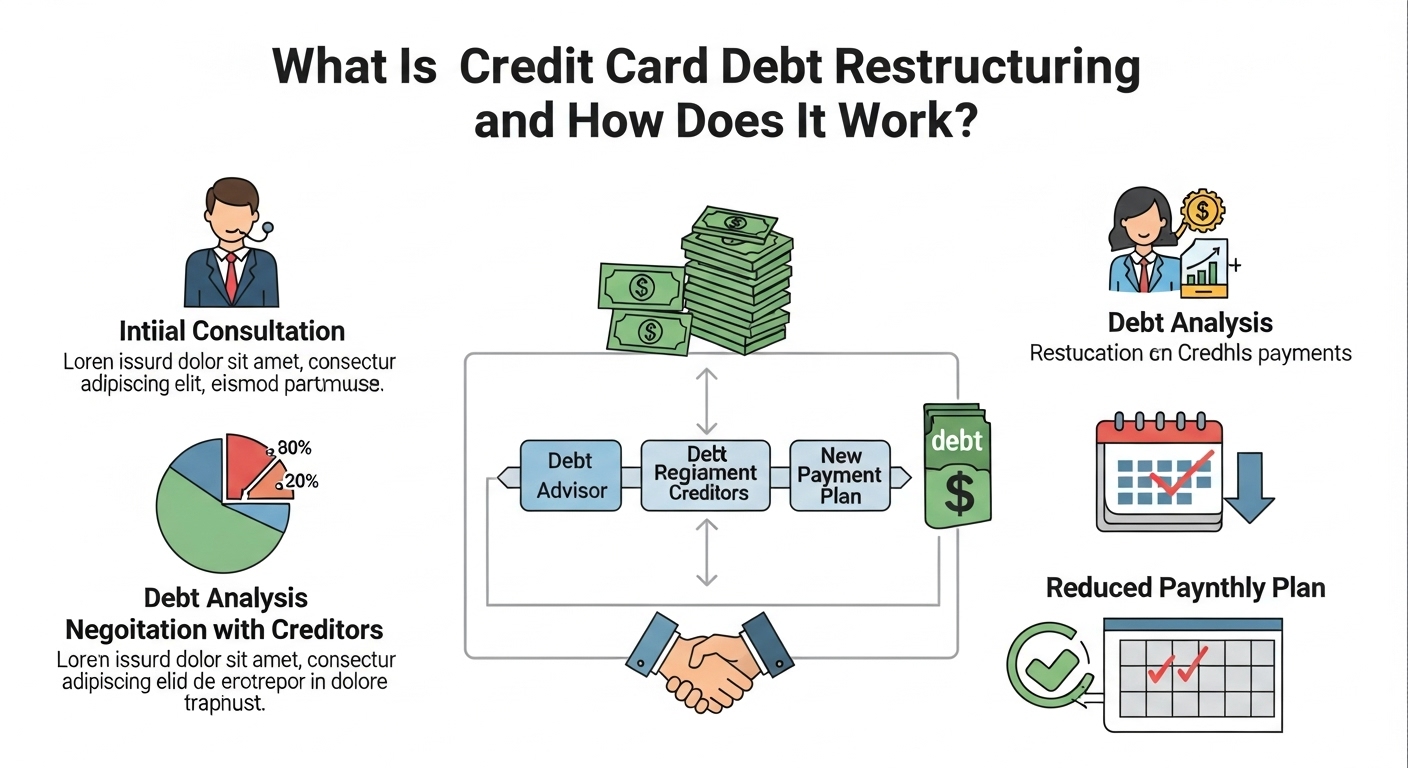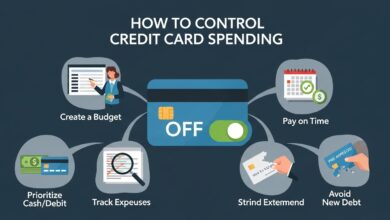What Is Credit Card Debt Restructuring and How Does It Work?

Credit cards offer flexibility and convenience, but if not managed carefully, they can quickly lead to overwhelming debt. High-interest rates, multiple payment deadlines, and unexpected expenses often make it difficult for cardholders to stay on track.
If you’re struggling to pay off your credit card debt, debt restructuring might be the solution you need. It allows you to reorganize your payments under more manageable terms — giving you room to breathe financially while protecting your credit from further damage.
In this article, we’ll explore what credit card debt restructuring means, how it works, and how to apply for it effectively.
1. What Is Credit Card Debt Restructuring?
Credit card debt restructuring is a financial process in which your bank or credit card issuer agrees to modify the terms of your debt repayment to make it easier for you to pay.
This can include:
- Lowering your interest rate
- Extending your repayment period
- Converting your revolving debt into a fixed installment plan
- Reducing or eliminating certain fees and penalties
The goal is to help you repay your debt gradually instead of falling into default, which could lead to legal action or severe credit damage.
In short, restructuring transforms your unmanageable debt into a realistic, structured payment plan.
2. Why Do People Restructure Their Credit Card Debt?
Debt restructuring is often used by people who:
- Struggle to pay the minimum monthly payments
- Have multiple credit cards with high balances
- Face financial hardship, such as job loss, illness, or unexpected expenses
- Want to avoid defaulting on their credit obligations
By restructuring your debt, you can regain control of your finances, avoid severe credit score damage, and stop the constant stress of collection calls.
3. How Credit Card Debt Restructuring Works
The exact process depends on your bank and country’s financial regulations, but it generally follows these steps:
Step 1: Contact Your Bank or Credit Card Issuer
Reach out to your bank’s collections or customer service department and explain your financial situation honestly. Most banks prefer helping customers restructure debt rather than forcing them into default.
Step 2: Financial Assessment
The bank will review your:
- Current debt balance
- Payment history
- Income and expenses
- Overall credit profile
This helps them determine a repayment plan that fits your ability to pay.
Step 3: Offer of Restructuring Terms
If approved, the bank may offer one or more of the following:
- A lower fixed interest rate
- A longer repayment term (e.g., 12–60 months)
- Waiver or reduction of late fees or penalties
- Consolidation of multiple debts into a single payment
You’ll receive a formal offer outlining all terms, including the new monthly payment amount.
Step 4: Agreement and Implementation
Once you agree to the restructuring plan, your revolving credit line may be frozen or closed, and you’ll start making fixed monthly payments based on the new schedule.
4. Benefits of Credit Card Debt Restructuring
Debt restructuring can be an effective way to regain control over your finances. Key benefits include:
✅ Lower Monthly Payments
You’ll have smaller, more manageable payments that align with your current financial situation.
✅ Reduced Interest Burden
Banks often reduce interest rates during restructuring, allowing you to pay more toward the principal balance.
✅ Avoiding Default and Legal Consequences
By restructuring, you avoid collection agencies, court cases, and wage garnishments.
✅ Peace of Mind
No more harassment calls or constant anxiety about missed payments.
✅ Protecting Your Credit Score
While your credit score may dip slightly due to restructuring, it’s far better than the long-term damage caused by unpaid debts or charge-offs.
5. Possible Drawbacks of Debt Restructuring
While debt restructuring can help you recover, it’s not without disadvantages:
⚠️ Temporary Credit Score Impact:
Since your account terms are modified, lenders may view you as a higher-risk borrower. However, this impact is usually short-term.
⚠️ Credit Card Suspension:
Most banks will freeze your credit card during restructuring to prevent further debt accumulation.
⚠️ Commitment Required:
You must stick to the new payment plan strictly — missing payments again could lead to cancellation of the agreement and renewed collection efforts.
⚠️ Interest Still Applies:
Although lower, interest will still accrue until the debt is fully repaid.
6. Restructuring vs. Debt Consolidation: What’s the Difference?
Many people confuse debt restructuring with debt consolidation, but they’re not the same.
| Feature | Debt Restructuring | Debt Consolidation |
|---|---|---|
| Definition | Modifying existing debt terms with your current lender | Combining multiple debts into one new loan |
| Lender | Usually your current bank or credit card issuer | A new lender or financial institution |
| Goal | Reduce interest, extend payment period | Simplify payments and possibly lower rates |
| Credit Impact | Moderate short-term impact | Can improve score if managed well |
If you owe debt to one bank, restructuring is a good solution. But if you have multiple cards and loans, consolidation might be more effective.
7. How to Apply for Credit Card Debt Restructuring
If you’re ready to apply, follow these practical steps:
- Assess your finances: Calculate your total debt, monthly income, and essential expenses.
- Prepare documents: Have proof of income, ID, and recent credit card statements ready.
- Contact your bank: Explain your financial hardship and request debt restructuring options.
- Negotiate: Don’t hesitate to discuss interest rates or payment terms — banks often have flexible programs.
- Review the agreement carefully: Ensure you understand all fees, terms, and payment schedules before signing.
- Stick to the plan: Make payments consistently and on time to rebuild trust and improve your credit profile.
8. Tips for Managing Your Finances After Restructuring
Once your debt has been restructured, focus on preventing future problems:
- Avoid new debt: Don’t apply for new credit cards until you’ve completed your plan.
- Create a budget: Track your income and expenses to stay within limits.
- Build an emergency fund: Save at least 3–6 months of expenses to handle unexpected costs.
- Use debit or prepaid cards: They help limit overspending while keeping you financially disciplined.
- Check your credit report regularly: Monitor your progress and ensure your payments are reported correctly.
9. Alternatives to Credit Card Debt Restructuring
If restructuring isn’t an option, consider:
- Debt consolidation loans — Combine multiple debts into one with lower interest.
- Balance transfer credit cards — Move your balance to a card with 0% introductory APR.
- Debt management programs — Work with a nonprofit credit counseling agency.
- Negotiating a settlement — Pay a lump sum for less than what you owe (as a last resort).
Each option has pros and cons, so evaluate them based on your situation and financial goals.
Final Thoughts
Credit card debt restructuring is a lifeline for those overwhelmed by debt. It doesn’t erase your obligations but makes repayment simpler, fairer, and less stressful.
By communicating honestly with your bank and committing to the new plan, you can regain financial stability, protect your credit, and start building a stronger financial future.
Remember — seeking help early is always better than waiting until your debt becomes unmanageable. Restructuring your credit card debt is not a failure; it’s a smart financial decision that can help you recover and rebuild.
